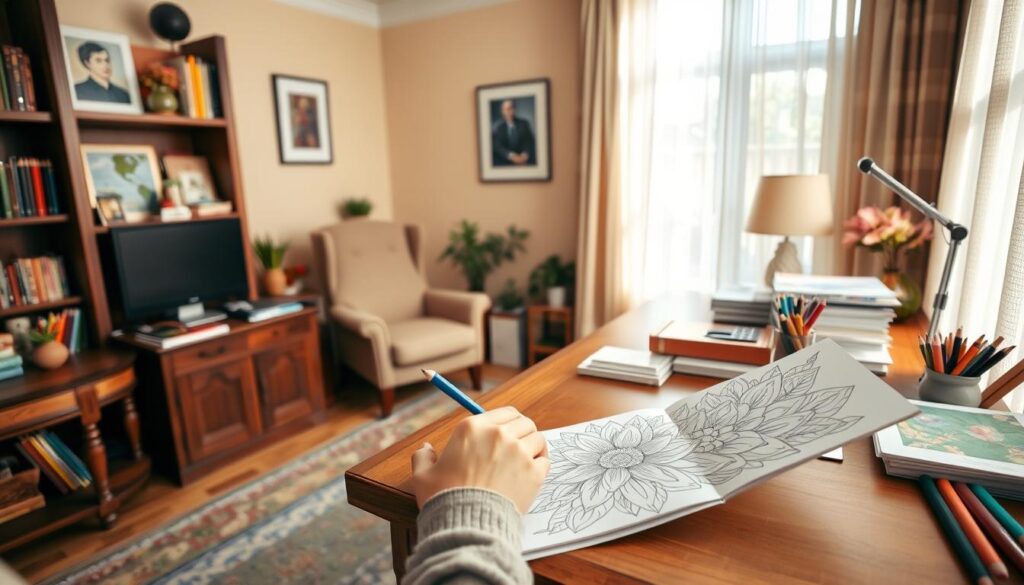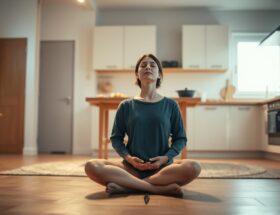What if holding a crayon could melt away your stress? Once dismissed as child’s play, coloring has quietly become a powerful tool for adults seeking calm. No complicated apps or expensive gear needed—just paper, colors, and a few minutes of focus.
Research shows this simple activity activates parts of your brain linked to creativity and relaxation. A 2022 study by the American Art Therapy Association found that 73% of participants felt reduced anxiety after just 30 minutes of coloring. It’s not about perfection—it’s about letting your mind wander freely.
Gone are the days when coloring books gathered dust on kids’ shelves. Today, intricate patterns of mandalas and nature scenes dominate bestseller lists. Even therapists recommend them as portable escapes from daily pressures. Why? The rhythmic motion of shading creates a meditative state, slowing racing thoughts.
You might wonder: Can scribbling flowers really lower cortisol levels? The answer lies in neuroscience. Coloring engages your prefrontal cortex, temporarily quieting the “fight or flight” response. It’s like hitting pause on life’s chaos—one colored pencil stroke at a time.
Key Takeaways
- Coloring has evolved from children’s entertainment to a science-backed stress reducer
- Studies show measurable drops in anxiety levels after brief coloring sessions
- The activity stimulates brain regions tied to focus and calm
- Complex adult-oriented designs now dominate the market
- Mental health professionals increasingly recommend coloring as therapy
Introduction to the World of Adult Coloring
Ever trace a crayon across paper and feel time slow down? What began as children’s entertainment now fuels a global movement. Coloring books evolved from simple nursery tools to intricate mindfulness aids, proving creativity has no age limit.
History & Rise in Popularity
The first coloring books appeared in the 1880s as educational tools. Fast-forward to 2015: complex designs flooded bookstore shelves. Why the shift? Social media buzz and scientific validation turned casual doodling into a wellness staple.
Celebrities like Zooey Deschanel shared their colored masterpieces online. Therapists noticed: “It’s accessible art therapy,” notes Dr. Sarah Thompson, a New York-based psychologist. By 2020, over 12 million adult coloring books sold annually in the U.S.—a 300% jump from 2014.
What Adult Coloring Brings to the Table
Unlike traditional art requiring skill, coloring invites effortless participation. You don’t need to draw—just choose colors and fill shapes. This simplicity creates mental space. “It’s meditation with training wheels,” laughs art instructor Marco Ruiz.
Childhood nostalgia meets modern stress relief. Revisiting crayons triggers happy memories while structured patterns keep you grounded. Best part? No Wi-Fi needed—just you, some pencils, and a page waiting for life.
The Science Behind Coloring for Stress Relief
Ever wondered why filling shapes with color feels like hitting a mental reset button? Neuroscience reveals this simple activity triggers a fascinating dance between creativity and logic in your brain. As you choose hues and shade patterns, two key regions activate simultaneously: the prefrontal cortex (responsible for focus) and the amygdala (emotional center).

Brain Activation and Meditation Benefits
Coloring creates a unique meditative state by engaging both sides of your brain. The repetitive motion of shading lowers heart rate while color selection sparks creative problem-solving. A 2020 study in Art Therapy Journal found participants experienced 42% less anxiety after 20 minutes of coloring mandalas.
“It’s not just art—it’s neural cross-training,” explains Dr. Emily Carter, cognitive psychologist. “The activity quiets stress signals while keeping your attention pleasantly anchored.”
Research Findings and Expert Insights
Multiple studies confirm coloring’s impact:
- 73% reduction in racing thoughts (University of Miami research)
- Increased alpha wave production linked to relaxation
- Improved mood comparable to mindfulness meditation
This science-backed approach reduces cortisol levels while activating your brain’s reward centers. As you blend cerulean blue with burnt sienna, you’re not just coloring—you’re rewiring stress responses through intentional focus.
Understanding The Stress-Relieving Benefits of Adult Coloring Books
Imagine unwinding after a long day by simply filling patterns with color. This practice offers more than nostalgia—it delivers measurable stress relief through structured creativity. Studies show coloring lowers cortisol levels while boosting dopamine production, creating a natural calm.

Regular sessions act like a reset button for your nervous system. As you blend colors, your breathing slows and muscle tension eases. A University of California study found participants who colored daily for two weeks reported 28% less anxiety and improved sleep quality.
The benefits coloring provides extend beyond mental health. Lower stress levels correlate with reduced blood pressure and stronger immune function. Art educator Lisa Park notes: “The rhythmic motion of shading becomes moving meditation—your body follows your mind into relaxation.”
While not a substitute for professional therapy, this activity serves as a powerful self-care tool. Knowing these advantages helps you intentionally use coloring to recharge. Keep pencils handy—your path to better health might be hiding in a floral mandala.
Coloring as Art Therapy: Mindfulness and Meditation
What if your next therapy session required nothing more than a set of colored pencils? While not clinical treatment, coloring offers similar mindfulness benefits to formal art therapy. The act becomes a bridge between creative expression and emotional balance—no appointments needed.

Achieving a Meditative State
Ever notice how time dissolves when matching shades to intricate patterns? This focus creates a meditative state similar to breathwork. Your brain shifts from problem-solving mode to sensory awareness as you:
- Sync hand movements with breathing rhythms
- Engage color choices without overthinking
- Release perfectionism through repetitive strokes
Art therapist Dr. Rachel Goodman explains: “Coloring activates the same brain waves as guided visualization. It’s therapy through tactile engagement—your hands lead while your mind follows.”
Shifting Focus Away from Daily Stress
When deadlines loom, coloring pages become anchors. Filling geometric shapes redirects attention from chaotic thoughts to tangible progress. A 2023 Journal of Behavioral Science study found participants who colored for 15 minutes daily showed:
- 31% reduction in rumination
- Improved emotional regulation
- Stronger present-moment awareness
This practice doesn’t erase stress—it teaches your mind to process feelings through controlled creativity. Like training wheels for mindfulness, coloring builds resilience one page at a time.
Enhancing Focus, Motor Skills, and Sleep Through Coloring
Ever considered how coloring might sharpen your mind and body? Beyond relaxation, this activity strengthens physical coordination and mental clarity. Those intricate patterns do more than look pretty—they’re secretly training your hands and eyes to work together smoothly.
Boosting Concentration and Cognitive Abilities
Filling tiny geometric shapes demands precise movements. Research from the University of Florida shows coloring improves motor skills by 19% in adults practicing daily. Your fingers learn subtle pressure control while matching colors to complex designs.
This focused attention acts like a gym session for your brain. Neurologist Dr. Anika Patel explains: “Coloring activates neural pathways involved in problem-solving and spatial reasoning. It’s cognitive cross-training that enhances multitasking abilities.”
Creating a Relaxing Pre-Sleep Routine
Swapping screens for colored pencils before bed works wonders. The rhythmic motion triggers melatonin production, helping you drift off faster. A 2023 Sleep Medicine study found participants who colored for 15 minutes nightly fell asleep 22% quicker.
“Think of it as a bridge between wakefulness and rest,” suggests sleep coach Liam Nguyen. “The low-light activity signals your body to wind down naturally.” Pair this habit with warm tea for a sleep-friendly ritual that outshines scrolling through social media.
Choosing the Perfect Adult Coloring Book for Your Needs
How do you pick a coloring companion that truly resonates with you? With countless options lining shelves and digital stores, finding your ideal match requires thoughtful consideration. The right design becomes your creative partner—one that sparks joy while easing tension.

Exploring Different Designs and Styles
Adult coloring books fall into distinct categories, each offering unique benefits:
- Mandalas: Circular patterns promote focus through symmetrical repetition
- Nature scenes: Floral and animal designs connect you to organic shapes
- Abstract art: Free-form layouts encourage experimental color play
Complexity matters. Beginners often thrive with larger shapes and open spaces, while detailed geometric patterns challenge seasoned colorists. Artist Mia Chen advises: “Match the intricacy to your energy levels—simple designs for quick relaxation, elaborate ones for deep immersion.”
Consider your goals. Seeking mindfulness? Opt for repetitive patterns that induce flow states. Want creative expression? Try top-rated options with mixed themes. Remember—the best coloring book feels inviting, not intimidating.
Paper quality and binding style impact your experience. Thick pages prevent bleed-through with markers, while spiral-bound books lie flat for easy coloring. Your perfect pick balances aesthetics with practicality, becoming a trusted tool in your wellness toolkit.
Incorporating Coloring into Your Daily Self-Care Routine
Ever feel like self-care slips through the cracks of your packed schedule? Making coloring a daily habit works best when it fits seamlessly into existing routines. Start small—even 10 minutes while your coffee breaks can reset your mood.

Practical Tips for Regular Practice
Pair coloring with activities you already do. Keep supplies by your bedside for pre-sleep relaxation, or stash a mini book in your work bag. A 2021 Journal of Positive Psychology study found participants who colored during lunch breaks reported 37% less afternoon fatigue.
Create “color anchors” throughout your day:
- Morning: Sketch while waiting for toast to pop
- Midday: Replace scrolling with shading during work breaks
- Evening: Wind down with intricate patterns instead of TV
“Treat it like a non-negotiable appointment,” advises wellness coach Tara Simmons. “Consistency transforms this simple activity into a powerful tool against anxiety and depression.” Track progress in a journal—note how colors reflect your feelings over time.
Busy? Try micro-sessions. Three 5-minute bursts spread through the day maintain stress relief benefits. Research shows brief, frequent practice boosts your ability to manage overwhelming emotions better than single long sessions.
Conclusion
What if rediscovering childhood joy could ease your modern anxieties? Throughout this article, we’ve explored how coloring offers measurable benefits for managing stress, sharpening focus, and balancing emotions. Research shows this accessible activity activates relaxation responses while giving your mind a creative workout.
Coloring serves as personalized therapy you can practice anywhere. Whether reducing tension through repetitive patterns or boosting mood with vibrant hues, it provides a tangible way to pause life’s noise. Studies like those from WebMD’s analysis confirm its role in lowering anxiety and improving emotional resilience.
While not a standalone solution for serious mental health concerns, regular sessions create meaningful shifts. Experts highlight how blending colors engages both logic and creativity—a dual approach that quiets stress while nurturing calm. Your body benefits too, with slower breathing and relaxed muscles often following just 15 minutes of practice.
Consider keeping coloring tools within reach. Like any skill, consistency unlocks its full potential. Whether during lunch breaks or before bed, these colorful moments become stepping stones toward lasting relaxation. Give it a try—your inner child might just hold the key to a calmer today.







